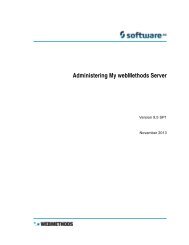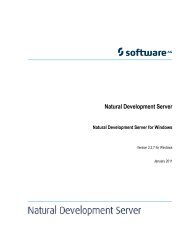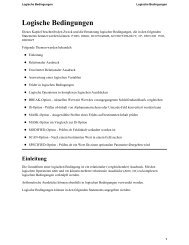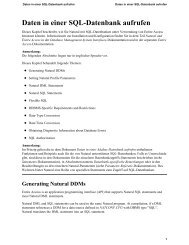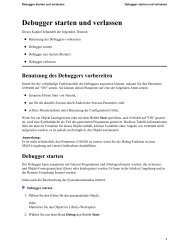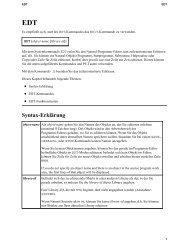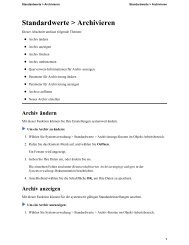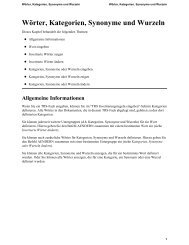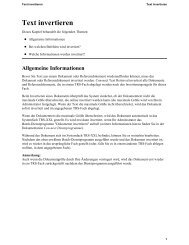Tamino XQuery User Guide - Software AG Documentation
Tamino XQuery User Guide - Software AG Documentation
Tamino XQuery User Guide - Software AG Documentation
You also want an ePaper? Increase the reach of your titles
YUMPU automatically turns print PDFs into web optimized ePapers that Google loves.
Advanced Usage<br />
Defining a Custom Output Handler<br />
You can define your own method of delivering the response document by using a server extension<br />
(SXS) as output handler. This output handler will then act in place of the internal <strong>Tamino</strong> <strong>XQuery</strong><br />
processor. In general you use:<br />
{?serialization method=""<br />
parameter=""?}<br />
For example, this allows using the XSLT server extension to transform query results on-the-fly:<br />
{?serialization method="XSLT.transform"<br />
parameter="stylesheets" parameter="stylesheets/patientRecords.xsl"?}<br />
<br />
{ for $a in collection('Hospital')/patient<br />
return { $a/name, $a/sex, $a/born, $a/address }<br />
}<br />
<br />
The method attribute identifies the output handler. The two parameters specify the XSL stylesheet<br />
to be used and the query. <strong>Tamino</strong> then passes the query result, the list of patients, to this output<br />
handler which transforms it using the stylesheet patientRecords.xsl.<br />
Please note that you can also use media-type in the serialization pragma for an output handler.<br />
Collations<br />
For certain operations on strings such as comparison or sort operations collations are used. They<br />
inherently determine the result of a comparison to accommodate for special regional purposes or<br />
linguistic needs. If a collation is not defined, <strong>Tamino</strong> uses Unicode codepoints for performing<br />
these operations. There are two ways to use collations: In the schema you can add collation information<br />
per element by using tsd:collation. In addition, you can assign a default collation in the<br />
query prolog such as:<br />
declare default collation "collation?language=fr"<br />
The string literal is the collation URI which is interpreted as relative URL with the base URI http://www.softwareag.com/tamino.<br />
In this example, the collation defined for the French language is<br />
used.<br />
You can use the <strong>Tamino</strong>-specific <strong>XQuery</strong> function tf:getCollation to deploy collations as in the<br />
following query:<br />
82<br />
<strong>XQuery</strong> <strong>User</strong> <strong>Guide</strong>




